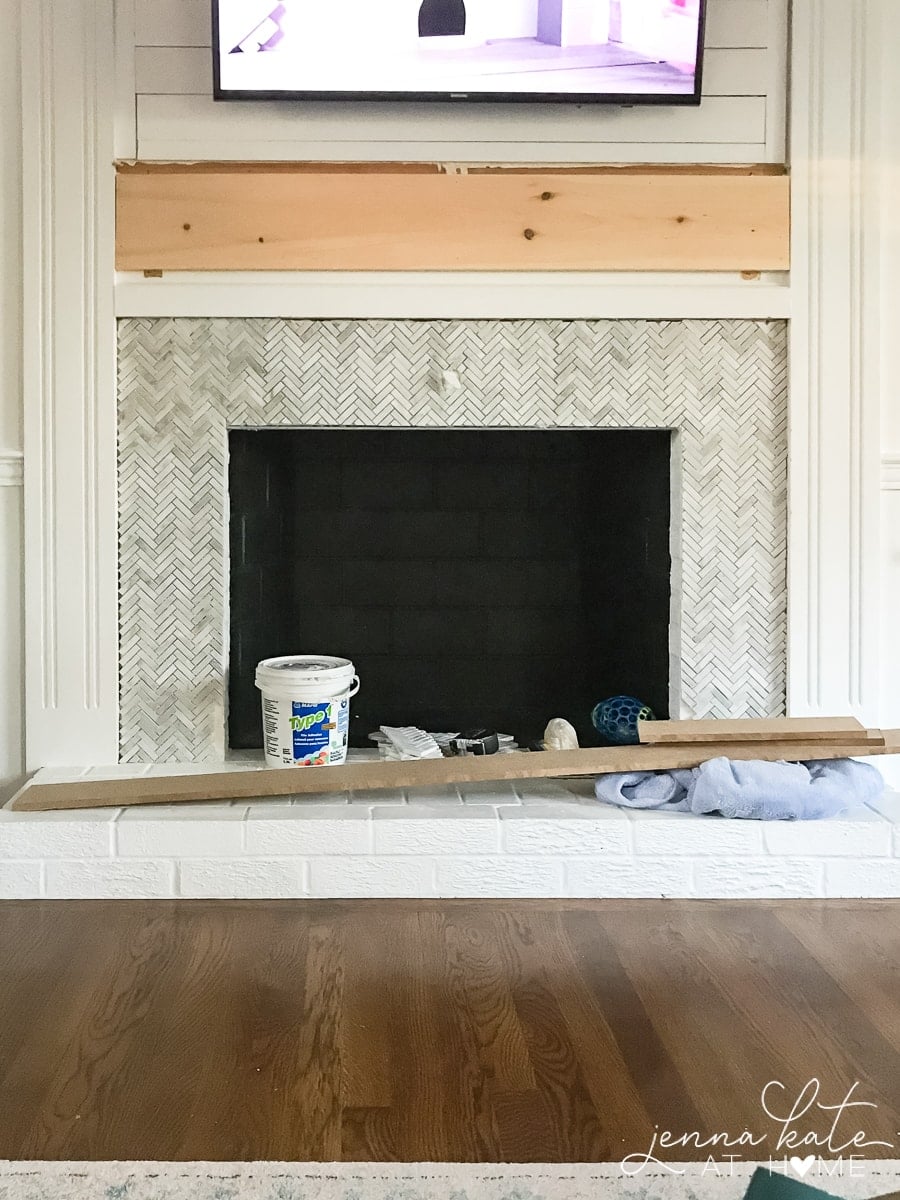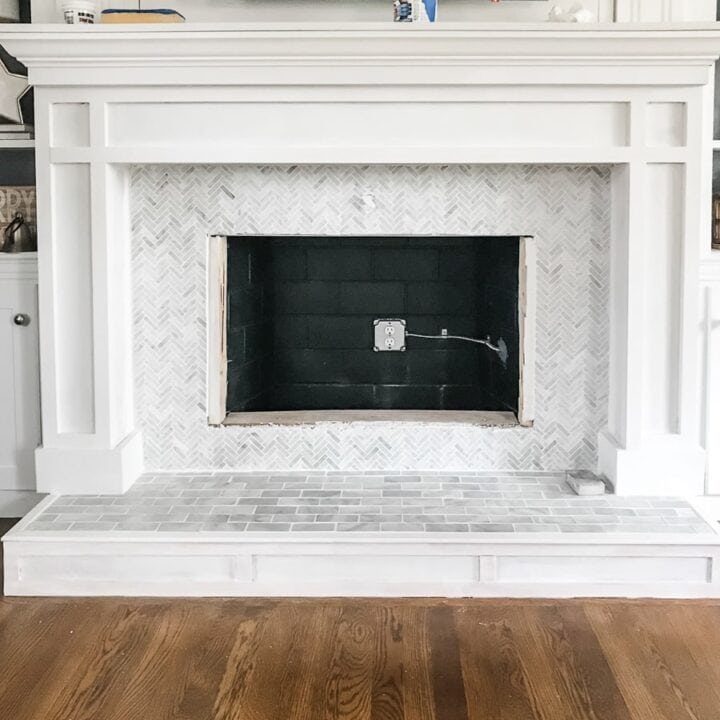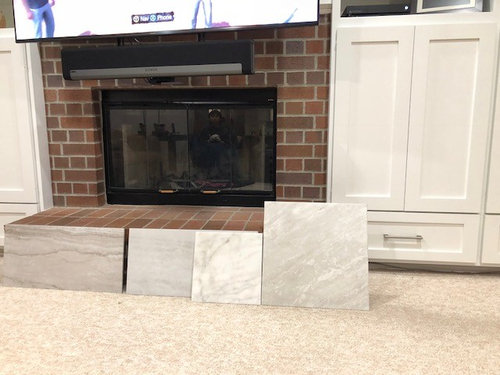Introduction to Marble Over Brick Fireplaces
The fireplace often serves as the focal point of a room, a place where family and friends gather to relax and enjoy each other’s company. Traditional brick fireplaces, while durable and classic, can sometimes feel outdated or clash with modern interior design trends. One popular and elegant solution to this issue is to update a brick fireplace by covering it with marble. Marble, known for its timeless beauty and sophistication, can transform an ordinary brick fireplace into a stunning centerpiece that enhances the aesthetic appeal of any living space.

Benefits of Using Marble
Marble is renowned for its elegance and luxurious appearance. Its natural veins and unique patterns add a touch of sophistication and exclusivity to any space. Beyond aesthetics, marble is also incredibly durable and heat-resistant, making it an ideal material for fireplace surrounds. The material can withstand high temperatures without cracking or warping, ensuring longevity and safety. Additionally, marble’s smooth surface is easy to clean and maintain, preserving its pristine look over the years.

Choosing the Right Type of Marble
Selecting the appropriate marble for your fireplace involves considering several factors, including color, pattern, and finish. Marble comes in a variety of shades, from classic white Carrara to deep, dramatic blacks. Each type has its unique veining and characteristics. For a more traditional look, lighter marbles with subtle veining might be preferred. Conversely, bold patterns and darker colors can make a striking, modern statement. The finish is another critical aspect; polished marble offers a shiny, reflective surface, while honed marble provides a more matte, understated look.

Preparing the Brick Surface
Before installing marble over a brick fireplace, proper surface preparation is crucial. The brick surface needs to be clean, dry, and free of any loose debris. Begin by scrubbing the bricks with a wire brush and a mixture of water and mild detergent to remove dirt and soot. Once clean, inspect the bricks for any damage or loose mortar, repairing as necessary to create a solid, stable base. Applying a bonding primer can help ensure the marble adheres properly to the brick surface, enhancing the durability of the installation.

Installing Marble Over Brick
The installation process involves several steps and requires precision to achieve a seamless, professional look. Start by measuring the fireplace area and cutting the marble tiles or slabs to fit. A wet saw is typically used to make precise cuts. Once the marble pieces are ready, apply a high-quality thin-set mortar to the brick surface, using a notched trowel to ensure even coverage. Carefully place the marble tiles, pressing firmly to secure them in place. Use spacers to maintain consistent gaps between tiles, which will later be filled with grout. Allow the mortar to cure according to the manufacturer’s instructions before grouting and sealing the marble.

Interesting Articles You May Want to Check:

Finishing Touches and Maintenance
After installation, the final steps include grouting the joints and sealing the marble. Grout helps fill the gaps between marble tiles, providing a cohesive look and preventing moisture from seeping behind the tiles. Choose a grout color that complements the marble and apply it using a rubber float, then wipe away excess grout with a damp sponge. Once the grout is dry, apply a penetrating sealer to the marble surface. This sealer protects the marble from stains and makes cleaning easier. Regular maintenance involves wiping down the marble with a soft, damp cloth and using a pH-neutral cleaner to preserve its shine.

Enhancing the Aesthetic Appeal
Marble not only elevates the visual appeal of a fireplace but also offers numerous opportunities for creative expression. The wide range of marble colors and patterns allows homeowners to tailor the look to match their personal style and the overall decor of their home. Whether aiming for a minimalist, contemporary vibe or a more opulent, classic ambiance, marble can be customized to achieve the desired effect.

Complementary Design Elements
To further enhance the marble fireplace, consider incorporating complementary design elements. Surrounding the fireplace with a custom mantel can create a cohesive look. Wood, metal, or even additional marble can be used for the mantel, depending on the desired aesthetic. Built-in shelving or cabinetry flanking the fireplace can add functionality and style, providing storage and display space while framing the marble beautifully. Lighting also plays a crucial role; strategically placed spotlights or sconces can highlight the marble’s texture and veining, adding depth and drama.

Seasonal Decor and Accessories
Adorning a marble fireplace with seasonal decor and accessories can keep the look fresh and inviting throughout the year. During the holidays, garlands, wreaths, and stockings can create a festive atmosphere. In spring and summer, fresh flowers, greenery, and lighter decor can brighten the space. Candles, artwork, and decorative objects can be used year-round to personalize the fireplace area. The versatility of marble means it serves as a perfect backdrop for various decorative themes and styles.

Integrating Technology
In modern homes, integrating technology with the fireplace area can enhance both functionality and aesthetics. Mounting a flat-screen TV above the marble fireplace is a popular choice, creating a sleek, unified entertainment center. Ensuring proper ventilation and considering heat-resistant materials is essential when combining electronics with a fireplace. Additionally, incorporating smart home features such as automated lighting and temperature control can add convenience and a touch of modern sophistication.

Common Mistakes to Avoid
Skimping on Preparation
Proper preparation of the brick surface is essential for a successful marble installation. Skipping steps like cleaning, repairing, and priming the brick can lead to poor adhesion and potential failure of the marble tiles. Ensuring a clean, stable, and primed surface will create a strong foundation for the marble, preventing issues down the line.
Choosing the Wrong Adhesive
Using an incorrect adhesive can compromise the integrity of the marble installation. It’s crucial to use a high-quality, heat-resistant thin-set mortar specifically designed for use with natural stone. Avoid using general-purpose adhesives, as they may not provide the necessary strength and durability for a fireplace application.
Ignoring Grout and Sealant
Grout and sealant are vital components of the marble installation process. Skipping these steps can lead to moisture infiltration, staining, and damage to the marble. Properly grouting the joints and applying a penetrating sealer will protect the marble and maintain its appearance over time. Regularly reapplying the sealant as recommended will ensure ongoing protection.
Improper Cutting and Fitting
Accurate measurement and cutting of marble tiles are crucial for a seamless finish. Using inappropriate tools or rushing through the cutting process can result in uneven edges and poorly fitting tiles. Investing in a quality wet saw and taking the time to measure and cut each piece precisely will achieve a professional-looking result.
Overlooking Maintenance
Marble requires regular maintenance to preserve its beauty and functionality. Neglecting routine cleaning and sealing can lead to staining, dullness, and damage. Using appropriate cleaners and resealing the marble periodically will ensure it remains in excellent condition, extending the lifespan of the installation.

What are the advantages of using marble over brick for a fireplace?
Marble offers several advantages over traditional brick for a fireplace. Its aesthetic appeal is unmatched, providing a luxurious and timeless look. Marble is also durable and heat-resistant, making it an ideal material for a fireplace surround. Additionally, marble is relatively easy to clean and maintain, ensuring it retains its beauty over time.
How do I choose the right type of marble for my fireplace?
Selecting the right marble involves considering color, pattern, and finish. Think about the overall decor of your room and whether you want the fireplace to blend in or stand out. Lighter marbles with subtle veining are ideal for a classic look, while darker marbles with bold patterns make a statement. The finish, whether polished or honed, will also affect the final appearance.
Can I install marble over my existing brick fireplace myself?
While it is possible to install marble over a brick fireplace as a DIY project, it requires careful preparation, precise measurements, and proper tools. Ensuring the brick surface is clean and primed, accurately cutting the marble, and using the correct adhesive are crucial steps. If you’re not confident in your skills, hiring a professional can ensure a flawless result.
How do I maintain and clean a marble fireplace?
Maintaining a marble fireplace involves regular cleaning with a soft, damp cloth and a pH-neutral cleaner. Avoid using acidic or abrasive cleaners that can damage the marble. Periodically applying a penetrating sealer will protect the marble from stains and moisture. Promptly addressing spills and stains will also help preserve the marble’s appearance.
What should I consider when integrating a TV or technology with a marble fireplace?
When combining a TV or other technology with a marble fireplace, consider heat management and proper installation. Ensure there is adequate ventilation to prevent overheating and damage to the electronics. Use heat-resistant materials and mount the TV at a safe distance from the fireplace. Consulting with professionals can help ensure both the marble installation and the technology integration are done safely and effectively.

Related Posts: